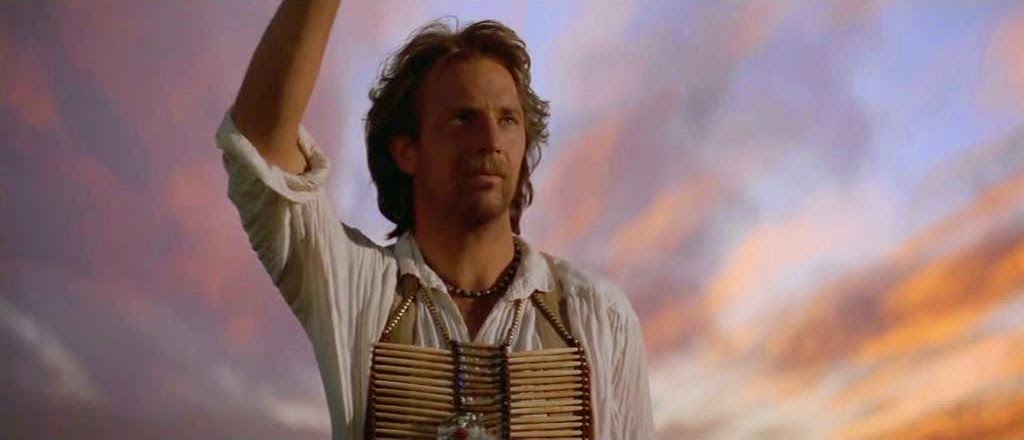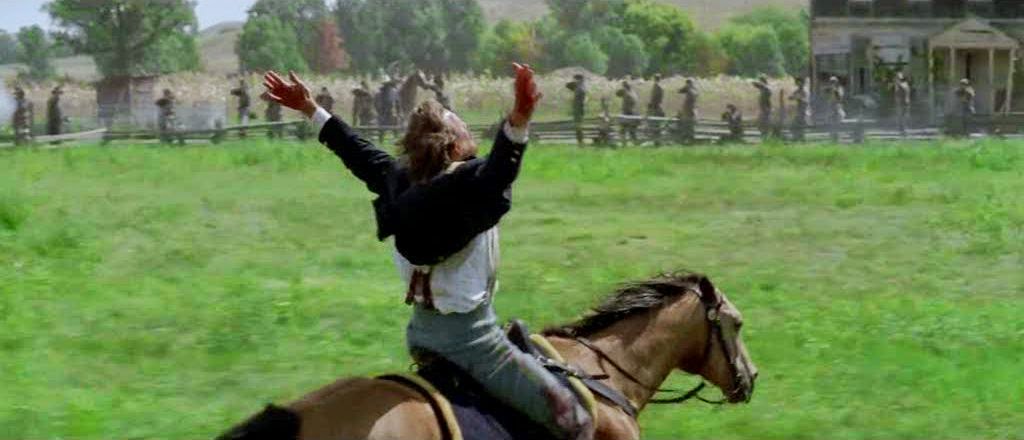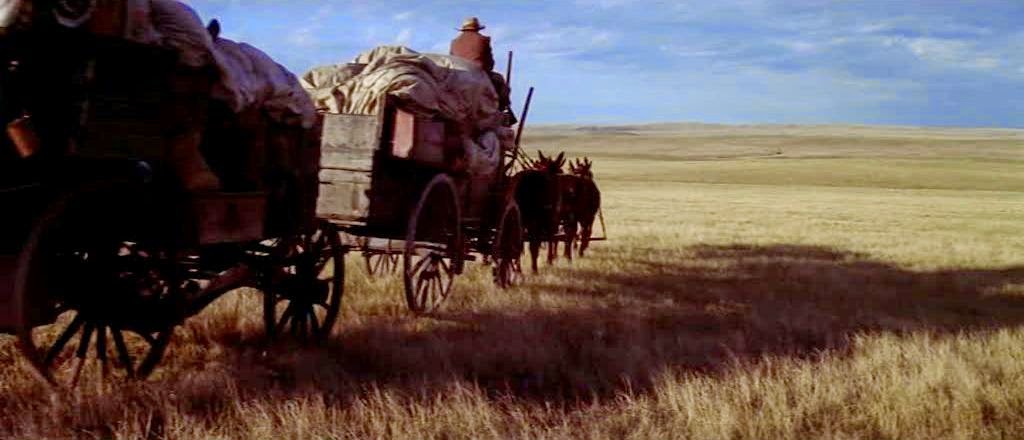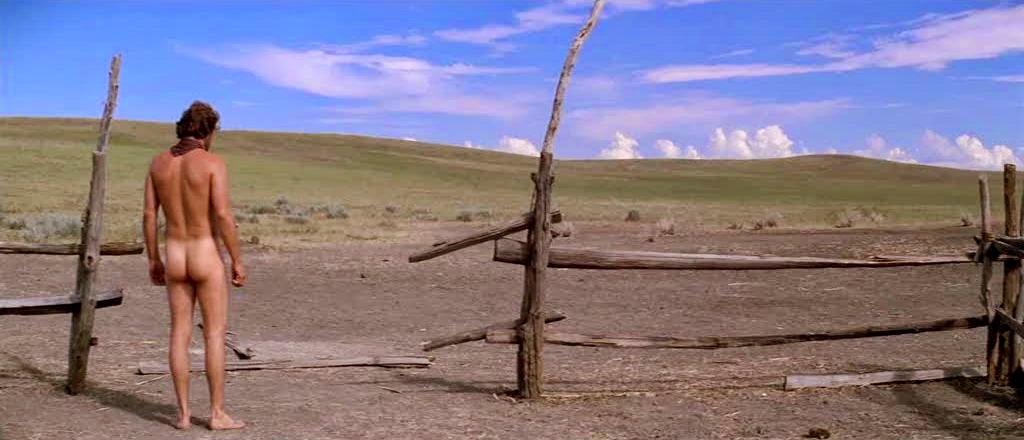
Widely acclaimed at the time as both a revival of the grand movie epic and a revivification of the Western genre enabled by a pro-Native American tilt, Kevin Costner’s debut film as director captured the 1990 Best Picture Oscar, only to be remembered chiefly thereafter by cinephiles for cheating Martin Scorsese’s Goodfellas of that glory. In retrospect that was classic case of the Academy presented with a divergence of artistic outlook, in facing two very different takes on the concept of genre revisionism: Costner’s sad but elegiac, idealistic take on terribly known yet still unfinished history, and Scorsese’s scabrous anatomy of modernity’s id. The AMPAS always knows which choice to make in such situations. Dances With Wolves wasn’t really that original in its outlook or incisions, standing in the shadows of films like Little Big Man (1970), A Man Called Horse (1970), Soldier Blue (1971), Jeremiah Johnson (1972), Buffalo Bill and the Indians, or: Sitting Bull’s History Lesson (1976), and other scattered Westerns from the genre’s sunset decade. It could be said Costner’s film lacks the ambivalence of some of those films, which tended to look askance at the savage side of both white and red men. Dances With Wolves is unabashed in manipulating the audience into loving its Sioux heroes and presenting the emissaries of European settlement apart from damaged war veteran John Dunbar (Costner) as brutal, sleazy, or moronic caricatures.

Costner’s film, a leisurely three hours in release cut (four in the director’s cut, which I watched when I finally caught up with this film), is at least admirable for its refusal to hurry, trying to attune the viewer to the beauty of the unspoilt west and the notion of natural harmoniousness, offering a space around the characters and their ways of seeing the world that prevents the film from lapsing entirely into either smarmy new-age fable or sado-masochistic fantasy like A Man Called Horse. Dunbar is introduced on a Union Army field hospital table about to have a leg sawn off after receiving a wound in a Civil War battle: rather than suffer the fate of a cripple, he pulls his boots back on and rides out hoping for the enemy’s coup-de-grace. Costner makes a play immediately for cinematic grandeur as Dunbar rides in slow-motion before the guns of the Confederacy with arms spread in best crucifixion pose, suggesting Dunbar – whose background and life story remain irritatingly opaque throughout the film – is a Christ figure and sacrificial lamb for white civilisation who is reborn as a new prophet of frontier race relations.

The visual language here is mythic, the actual mechanics of the sequence pretty absurd. Costner’s posing also harks back to other male movie stars who courted messianic suffering and ascension like Brando, Hopper, and Newman, but Costner never matches their gifts for capturing the suffering. Dunbar is a blank slate for the modern audience to project upon as he survives this unlikely adventure, is saved and decorated by a General, and, as is his privilege, volunteers for duty on the further fringes of the frontier. Dunbar’s journey west is punctuated by glimpses of such moral and mental rot in his world visualised in the most clichéd terms as he encounters gross and pathetic emissaries of that world, including an alcoholic Major, Fambrough (Maury Chaykin), who urinates in his own pants and shoots himself moments after Dunbar leaves him, and Dunbar’s slovenly agent escort to the frontier, Timmons (Robert Pastorelli). The hapless CO in charge of Dunbar’s intended post leads his bedraggled and mutinous men away just before Dunbar arrives, leaving behind a scarred and blemished place that haunts Dunbar with its Marie Celeste-like quality. Dunbar however enjoys his solitude and respite from conflict, kept company only by a single, bedraggled coyote, and then has his little world visited by a nearby encampment of Sioux.

The film is at its best in the section where the solitary soldier and the aboriginal warriors suspiciously, half-foolishly probe each-other for signs of aggressive intent or potential amity, and develop friendship in a manner Costner does his darndest not to rush. Oneida actor Graham Greene plays Kicking Bird, the tribe’s medicine man, and the first to encounter Dunbar, scared off by the sight of the soldier advancing on him in anger whilst stark naked, as Kicking Bird seems to be stealing his horse. Kicking Bird, like the Reverend who saw Yossarian in the tree in Catch-22, discerns a magnificent omen in this, whilst his fellows, like hot-headed Wind In His Hair (Rodney A. Grant), at first see only an intruder to be chased off or killed. Contact is soon made, however, as Dunbar charms his neighbours by grinding coffee for them and saving a tribally adopted Anglo woman, Stands With A Fist (Mary McDonnell) from suicide after her husband is killed in battle with the Pawnee. He’s finally accepted as a friend by the tribe when he alerts them to a passing buffalo herd and helps in the hunt. He is steadily absorbed into their number, even landing the name Dances With Wolves for his habit of cavorting with his wolf pal in the moonlight, and begins to romance Stands With a Fist, a pairing that pleases his fellows although she’s still supposed to be in a mourning period for her first husband.

Australian cinematographer Dean Semler, who had painted the Aussie mythological west in similarly sprawling, hyper-vivid terms in The Man From Snowy River (1983), won an Oscar amidst the film’s clutch of awards for his efforts here, and his work was certainly integral to the film’s lustre. Dances With Wolves is constantly punctuated with Semler’s lovingly crafted images that paint the Dakota locations in roiling curves of brown and rays of gold, cleansed by nature and cleansing the soul of the receptive. But Costner’s directing is uneven and largely prosaic, settling for a moseying pace and simple scene set-ups, and using Semler’s vast landscape shots as punctuation rather than poetry: if the film’s substance and drama are flagging at any point, here’s another gorgeous vista to knock your socks off. Whereas for David Lean or John Ford landscape was an expressive instrument tied to the psyches of their characters and the ebb and flow of social values upon the arena of an antipathetic environment, for Costner it’s Edenic tourism, a clean and pretty universe to match his idealised vision of Native American life as communal idyll about to be disrupted by big bad civilisation. Still, Costner’s direction reveals acuity for occasionally eye-catching images, including of himself standing bare-assed before a vast landscape. He often effectively mimics Ford’s method for animating a potentially empty frame with diagonal and lateral compositions, as columns of horsemen and wagons cross the screen, mobile islands of humanity on oceanic plains.

Costner and screenwriter Michael Blake (adapting his own novel) noticeably cop out of studying any clash between Dunbar’s PTSD humanism and the inimical aspects of the Sioux’s attitude, and set up conflict situations where the wheels of cross-cultural communication might jam, but then abandon them. Dunbar looks askance at their casual butchery of some hunters for doing the same to some buffalo, and his romance with Stands With a Fist, which violates a taboo, only to be casually let off the hook by Greene’s grumpy but indulgent Kicking Bird. Such discursions essentially turn the bulk of the film into a frontier situation comedy where a man gets along with his kooky neighbours and learns to laugh and love with them, in spite of all the pretences. Apart from intimations of unease about how the tribe will eat before the herd shows up, Dances With Wolves feels romanticised to a tendentious degree, offering a cleaned-up wild west where hunger is not a problem at the moment, the bad guys are an evil band of Pawnees (led with swagger by the ever-striking Wes Studi) who relish murdering Timmons, or sweaty, uncouth Union thugs, whilst life amongst the Sioux adds up to an idealised vision that even the commune dwellers of Easy Rider (1969) might find a bit dubious. Dunbar’s low-key romance with Stands With A Fist would be less funny if McDonnell’s hair didn’t look like the before shot in a Garnier Fructis ad. Certainly nothing as humorously bawdy as Little Big Man’s extended sister shag gets through here.

Not to suggest that represented any more realistic a version of Native American social niceties than this, but Costner’s film certainly smoothed the crude fodder of both history and art down to a palatable paste fit for equitable consumption, the earthiness the film proposes to celebrate actually carefully tamed. Costner’s approach is actually diametrically opposed to the gritty ethics of the ‘70s genre redefinition. Costner films a few buffalo slaughtered by hunters as a tremendous tragedy – effectively and efficiently sensitising the viewer to the Sioux viewpoint of this as disgusting waste – but then essentially dismisses the subsequent killing of the hunters, which happens off-screen, only momentarily stalling Dunbar’s emotional gravitation to the tribe, thus leaving Dunbar’s emotional landscape seeming awfully shallow. That Costner gets away with this sort of thing is chiefly thanks to the quality of his casting, and the loping-paced but enveloping rhythm he hits on, a rhythm that gives the illusion of contemplative realism and a quiet emotionalism. Greene’s effectiveness as the quietly philosophical, concerned Kicking Bird matches Costner’s generally unshowy performing, and the two men interact well, especially in a later sequence when Dunbar works up the nerve to warn Kicking Bird what’s coming in the inevitable white invasion. Grant is excellent as the fearsome but deep-feeling Wind In His Hair, as is Floyd Red Crow Westerman as Ten Bears, the village elder. By comparison, Chaykin is humiliated by a foolish few minutes of overdrawn instability.

The film’s most famous sequence is the tribal buffalo hunt, staged by Costner and filmed by Semler as an ebullient piece of widescreen showmanship, rendered with a skill that cuts to essence of both the corporeal and spiritual sides of the Western genre, liberation of the spirit and unification with the land enacted in the most primal and pragmatic of activities. Another, less effective action sequence comes when Studi’s Pawnee band raids the Sioux whilst most of the warriors are away, forcing Dunbar to loan out his guns, allowing victory with old folks and women and cementing Dunbar as Dances With Wolves, the name he finally claims as his own when he’s captured and beaten by Union soldiers who turn up uninvited at the outpost. Costner’s seriousness repeatedly wanes when he tries to incorporate blunt melodramatic satisfactions. He makes sure no-one objects to the Sioux killing white soldiers by rendering them as mostly a collective of obnoxious bullies who beat and maim Dunbar, in a study of excess: he’s knocked out after trying to attack one of them no less than three time, and his fellow soldiers also kill his horse and his wolf friend. That, sir, will not stand. The Pawnees are also signalled as evil because they kill a Sioux guard dog, as if it wasn’t enough that Studi has already riddled Timmons with arrows and scalped him alive. Costner adds a smidgen of ambiguity by having a well-behaved Yankee officer killed in the attack that saves Dunbar too.

Dances With Wolves never however feels like a work that’s had a deep amount of thought poured into it. It represents rather a series of strong if convenient emotional postures. Native Americans are good, except those ones; white Americans are bad, except for that one. War is bad at the start, but murderous revenge is cool. Dunbar saves his new community by introducing it to the arts of mechanised slaughter he’s supposed to be running away from, and Costner and Blake have no apparent interest in the contradiction. Visual oppositions and cultural clashes are simplistic. Whereas the final image of Jeremiah Johnson moved me greatly because it offered a moment of recognised kinship that came in spite of and because of the acknowledged brutality of the West, Costner’s film offers pat escapes and dull uplift. But his film is a long way from bad, for it remains absorbing and sleekly watchable even at such a length, and has genuine love invested in its frames. Undoubtedly, Costner’s arrow hit its mark in his moment’s culture, taken as a much-needed corrective, whilst turning himself into the biggest star in the world in the process, for a reign that proved very short as he overreached. The impact of the film also all but rescued the Western from total oblivion (along, perhaps, with the successful teen-oriented Young Guns, 1988) after Costner had starred in one of the last major entries, Silverado, five years earlier, whereas a small glut followed, some of them trashy and popular (Tombstone, 1993), some epic and doomed (Geronimo: An American Legend, 1993; Wyatt Earp, 1994), and another Oscar-garlanded hit, Clint Eastwood’s Unforgiven following just two years later. But two filmmakers who ran much further with Costner’s thematic ball were Jim Jarmusch with Dead Man (1995), which, most tellingly, picked up on the spirituality in Costner’s narrative and turned it inside out, along with some of the racial politics, and Terence Malick would take up the theme of violated Edens and imminent calamity in more inventive terms with The New World (2005). Edward Zwick’s The Last Samurai (2003) is a rip-off in different locale, whilst James Cameron’s Avatar (2009) is remake in sci-fi clothing.




















